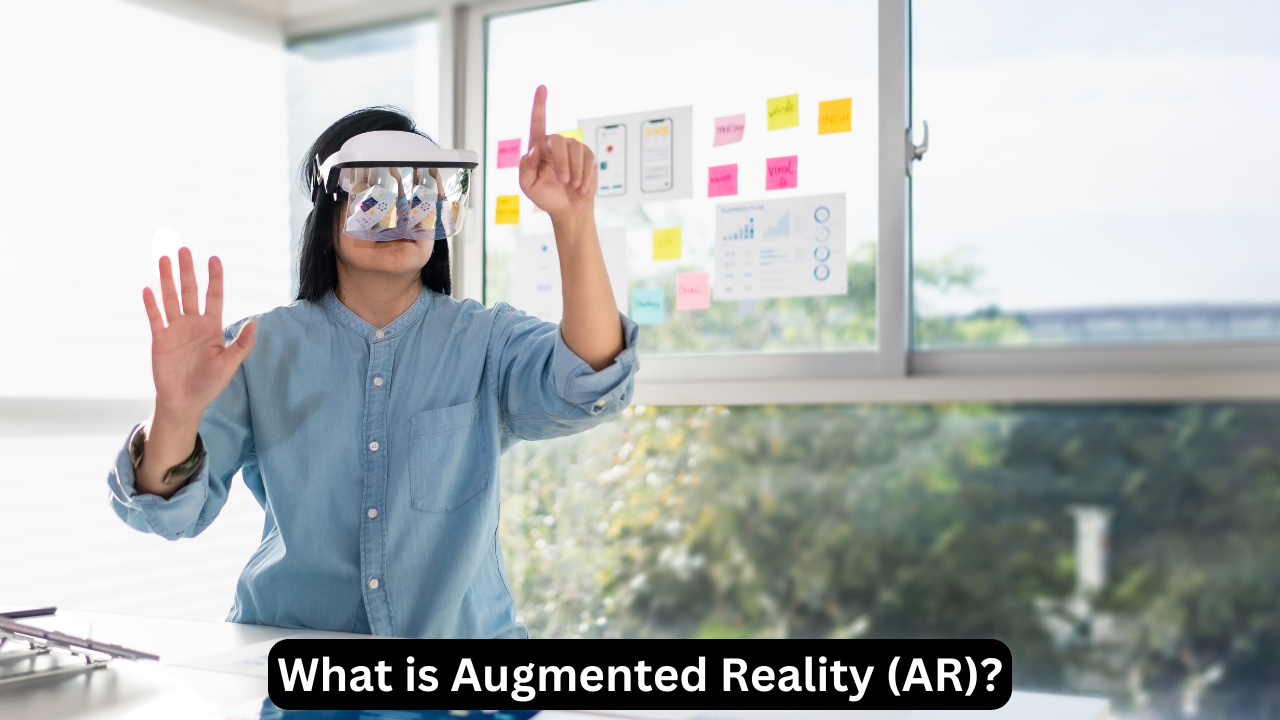Augmented Reality (AR) enhances the real world by overlaying digital content, offering practical applications across industries like gaming, healthcare, retail, and education for a more interactive and efficient experience.
In recent years, Augmented Reality (AR) has emerged as a groundbreaking technology, transforming the way we interact with digital content and our surroundings. AR blends real-world environments with digital elements in real-time, creating a seamless experience that has found its application across various industries. From gaming to healthcare, AR is influencing and enhancing the way we live, work, and play. In this article, we will explore what Augmented Reality (AR) is, its applications, how it works, and its impact on different sectors. We will also delve into the future potential of AR and its role in shaping the digital world.
What is Augmented Reality (AR)?

Augmented Reality (AR) is a technology that overlays digital content such as images, sounds, and other sensory stimuli onto the physical world in real-time. Unlike virtual reality (VR), which creates an entirely virtual environment, AR enhances your real-world view by adding digital elements. This combination allows users to experience a richer, more immersive interaction with their environment.
The core of AR lies in its ability to merge the digital and physical worlds, creating a hybrid reality where the boundaries between both realms become indistinguishable. Some of the most well-known examples of AR in action include the popular mobile game Pokemon Go, which allowed users to see digital creatures placed in real-world locations, and Snapchat filters, which superimpose digital effects onto users’ faces.
Key Characteristics of Augmented Reality
- Real-time Interaction: AR content is rendered in real-time, enabling dynamic interaction with the environment.
- Context Awareness: AR can adapt the digital elements based on your physical location and surroundings.
- Hardware and Software Integration: AR requires a combination of hardware (e.g., smartphones, AR glasses) and software (e.g., AR applications) to function effectively.
How Does Augmented Reality (AR) Work?
The technology behind Augmented Reality (AR) combines hardware, software, and computer vision techniques to display digital content overlaid on the real world. The process involves several key components:
- Camera and Sensors: Devices such as smartphones or AR glasses use cameras and sensors to capture the user’s surroundings. These sensors help the device understand the environment, track movement, and identify specific markers.
- Processing and Interpretation: The device’s processor interprets the captured data, identifies the location and orientation, and renders the appropriate digital content.
- Display: Once the digital content is processed, it is projected onto the user’s view through the display, whether it’s through a phone screen, smart glasses, or headsets.
- User Interaction: AR systems allow users to interact with digital elements, such as moving, resizing, or even triggering certain actions based on their gestures or touch input.
Types of Augmented Reality
- Marker-based AR: Uses physical markers (QR codes, images, etc.) to trigger AR content when detected.
- Markerless AR: Utilizes GPS, compass, and other sensors to display AR content based on the user’s location or environment.
- Projection-based AR: Projects digital content directly onto physical surfaces, often used for interactive installations.
- Superimposition-based AR: Replaces or adds to the view of the physical world, such as visualizing a new car design on the street through a mobile app.
Applications of Augmented Reality (AR)
The use of Augmented Reality (AR) spans a wide range of industries, revolutionizing the way businesses interact with customers, and changing how we engage with the world. Below are some notable applications of AR:
1. AR in Gaming
AR gaming has gained massive popularity, particularly with the success of Pokemon Go, which used real-world locations as the backdrop for virtual gaming experiences. Games that use AR allow players to interact with their physical environment while still being immersed in a virtual world. This blend of reality and fantasy is creating new possibilities in the gaming industry.
2. Healthcare and Medicine
AR is transforming healthcare by enhancing training, diagnostics, and patient care. Surgeons, for example, can use AR glasses during operations to view real-time data or imaging overlays, improving precision. Similarly, AR applications are helping in mental health treatment by offering virtual therapy or relaxation exercises.
3. Retail and E-Commerce
The retail industry is also leveraging AR to enhance shopping experiences. Virtual try-ons for clothes, glasses, and makeup have become a popular feature in many e-commerce platforms. IKEA’s AR app allows customers to visualize how furniture would look in their homes before purchasing.
4. Education and Training

AR is a powerful tool for education, offering immersive learning experiences. Whether it’s for learning complex anatomy in medicine or understanding historical events in history class, AR enhances visual learning. Students can engage with interactive 3D models and simulations that make the learning process much more engaging and effective.
5. Real Estate
In real estate, AR enables virtual property tours, allowing potential buyers to visualize homes and buildings without being physically present. This innovation is especially useful in large real estate markets, offering an immersive way to explore properties remotely.
6. Architecture and Construction
AR assists architects and engineers in visualizing their designs in the real world before construction begins. By overlaying virtual models on actual spaces, AR helps stakeholders better understand design concepts and make changes in real-time, reducing errors and improving efficiency.
7. Navigation and Tourism
AR-based navigation apps provide more interactive and informative directions, guiding users through streets, shopping malls, or airports with on-screen directional prompts. In tourism, AR can provide travelers with enhanced historical information about landmarks by scanning certain sites through their smartphones.
8. Marketing and Advertising
Marketers are using AR to create interactive ads that engage customers in a new way. AR experiences are more captivating, allowing users to engage with brands directly by trying out products, participating in contests, or exploring virtual stores.
The Impact of Augmented Reality on Industries
The integration of Augmented Reality (AR) is reshaping various sectors, making them more efficient and customer-centric. Here’s how AR is impacting some of these industries:
- Healthcare: By enhancing surgical procedures, diagnostics, and remote consultations, AR is improving patient outcomes and reducing the likelihood of human error.
- Retail: AR is revolutionizing the shopping experience, with customers now able to try products virtually before buying them, significantly improving conversion rates for retailers.
- Manufacturing: AR is used to provide workers with real-time data, improving productivity and reducing the need for extensive training.
- Education: AR has the potential to revolutionize education by providing hands-on, experiential learning opportunities that traditional methods cannot replicate.
The Future of Augmented Reality (AR)

The future of Augmented Reality (AR) is incredibly exciting, with continuous advancements in technology paving the way for more sophisticated applications. As AR hardware improves, and as more industries adopt the technology, we will see new use cases emerge. From the evolution of AR in smart glasses to its integration in autonomous vehicles, the potential of AR is limitless.
In the coming years, we can expect Augmented Reality (AR) to become even more integrated into daily life, as the technology becomes more affordable, intuitive, and scalable. With AR, we might be able to engage with the world in entirely new ways, blending the physical and digital realms seamlessly.
Key Differences Between AR and VR
| Feature | Augmented Reality (AR) | Virtual Reality (VR) |
|---|---|---|
| Definition | AR overlays digital content on the real world. | VR creates an entirely immersive, virtual environment. |
| Immersion Level | Enhances the real world with digital elements. | Fully immerses the user in a virtual environment. |
| Hardware Requirements | Requires devices like smartphones, tablets, or AR glasses. | Requires VR headsets, controllers, and motion sensors. |
| Interaction | Allows users to interact with both the real and digital world. | Users interact only with the virtual environment. |
| Applications | Used in gaming, retail, education, healthcare, and navigation. | Mainly used for gaming, simulations, and training. |
| User Experience | Users remain aware of their physical surroundings. | Users are completely immersed and detached from their surroundings. |
| Example | Pokemon Go, Snapchat filters, IKEA’s AR furniture app. | Oculus Rift, HTC Vive, and PlayStation VR gaming systems. |
This table helps clarify the fundamental differences between AR and VR, making it easier for readers to understand how each technology functions and is applied in various fields.
FAQs about Augmented Reality (AR)
1. What is the difference between AR and VR?
While Augmented Reality (AR) overlays digital content onto the real world, Virtual Reality (VR) creates a completely immersive environment, replacing the physical world with a simulated one. AR enhances reality, whereas VR creates an entirely new experience.
2. How does AR work on mobile devices?
AR works on mobile devices through the camera, sensors, and software. The camera captures the user’s environment, and the software processes and overlays digital content, which is displayed on the mobile device screen.
3. Can AR be used without internet?
Yes, some AR applications can work without an internet connection, particularly those that don’t require real-time data streaming. However, many advanced AR apps, like those in navigation or e-commerce, may require internet access to retrieve additional information.
4. What are the benefits of AR in education?
AR in education offers immersive, interactive learning experiences that can make complex concepts easier to understand. It also helps engage students more effectively, enhancing the overall learning process.
5. Is AR the future of gaming?
Yes, AR is rapidly becoming a major part of the gaming world. It offers a unique way for players to interact with their environment and other players, creating a more immersive and dynamic gaming experience.
6. What are some challenges in AR development?
Some of the challenges in AR development include high costs for advanced hardware, the need for precise real-time tracking, and ensuring the accuracy and relevance of the digital content displayed. Additionally, user adoption and privacy concerns can also be hurdles.
Conclusion
Augmented Reality (AR) is undoubtedly one of the most transformative technologies of the modern age. From enhancing daily activities to revolutionizing entire industries, AR offers a wealth of opportunities. As the technology continues to evolve, its integration into our lives will only grow, offering new ways to interact with both the physical and digital worlds. Whether in gaming, healthcare, or education, the future of AR is bright, and it is poised to become an integral part of our everyday lives.
Augmented Reality (AR) holds the potential to reshape how we interact with our surroundings, making it a key player in the technological landscape of tomorrow. Please follow out blog Technoloyorbit.


